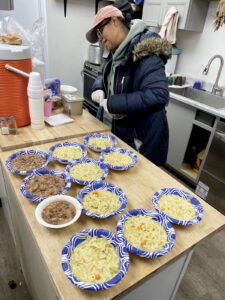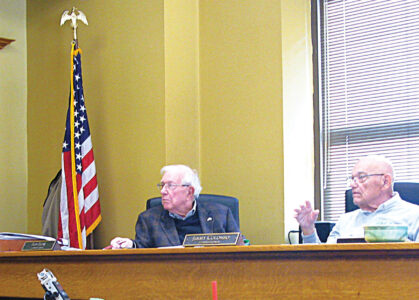Barker House caretakers detail restoration, finds

Tony Durm, a member of Friends of the Joseph Barker Jr. House, was first to discover the partial signature of “Joseph B” on a house rafter. With help from Marietta College Special Collections, handwriting samples of Joseph Sr. and Joseph Jr. were compared. Although the discovery does not provide absolute proof that Joseph Barker Sr. built the house, it does give “strong credence” to that theory, which is part of the local historical narrative. (Photo Provided)
NEWPORT — Since becoming caretakers of a piece of local history last year, Friends of the Joseph Barker Jr. House have taken careful, steady steps to get a closer look at what is there and what needs to be done.
“Before last September, we were only in the house twice in the past several years, and our real concern was that it could collapse,” said Tony Durm, Vice President for Restoration for the FJBJ House..
“First, we cleared 50 years’ worth of growth and debris outside,” he said. “We got through that and then made a big effort to get the roof repaired. There has been considerable damage from the leaks for the past couple of decades,” he said, “mostly in the frame portion of the house. It’s taken a real hit, and the moisture has made it a haven for termites.”
The good thing is that in the brick part, the significant damage is rather limited, he said.
The frame part of the house is what is seen from the highway and the brick portion faces the Ohio River.
Now that FJBJ has cleaned up debris in the house, members of the non-profit group have been scouting around to identify what needs fixed and what the structural issues are.
“Yes, the damage is bad, but it’s actually not as bad as we feared,” Durm said. “I can walk in the house now and not be afraid that it’s going to collapse on me.”
There have been a couple of unique finds during the first top-to-bottom and front-to-back inspection of the house, Durm said. Those are detailed on the FJBJ House website, barkerhouse.org, in a narrative titled “Exciting discoveries at the Barker House.”
A portion of the website narrative explains that there has not yet been any documentary confirmation located concerning Joseph Barker Sr.’s role in designing and building the house, even as “local lore” has asserted that was the case.
“During our recent inspection of the house, we ventured all the way to the attic of the brick section, carefully making our way across weathered floors and staircases. Vice President for Restoration Tony Durm was the first to spy a faint inscription on an original rafter board, applied, it appears, in black ink with a brush. Even in the dim light of that space, we immediately recognized what was written in script. Photographs were taken and subsequent image enhancement by Tony’s son Todd, a professional photographer, confirmed that we were seeing the signature ‘Joseph B’ (and possibly part of the ‘arker’)!
“Such an out-of-the-way placement seems more likely to reflect the subtle memorialization of a builder, rather than the declaration of an owner and occupant. But which Barker was it – Joseph Senior or Junior?
“With the help of Linda Showalter of Marietta College Special Collections, we were able to assemble multiple examples of both father and son’s signatures, which evidence rather different handwriting styles. Although we are not handwriting analysis experts, it seems obvious that the script signature on the house rafter is that of Joseph Barker Senior. While this may not give absolute proof that he built the house, we feel it lends strong credence to that part of the local historical narrative.
“In another area of the structures, we encountered an incredible stone sink – large, expertly fashioned and in excellent condition. In fact, FJBJ Vice President for Preservation Bill Reynolds – well-versed in all things pioneer – declared that this is one of the best preserved stone sinks he’s ever encountered in Washington County!”
The website narrative concludes:
“As we become more familiar with the Barker Jr. structural complex, we are more convinced than ever that it is a gem-in-the-rough worth restoring, even as we recognize the huge task ahead to accomplish this objective. We appreciate your continuing interest and support in this effort!”
Two professional architectural evaluations of the complex were funded by the U.S. Army Corps of Engineers in 1981 and 2014, and another Historic Structure report from the Corps is being completed now. The studies include extensive archival research on the structure’s historical aspects, Durm said.
“They want to see what is historically important and what is salvageable.”
Once that is established, the report can become a primary tool used in seeking grants for future restoration, Durm said.
Nancy Taylor can be reached at ntaylor@newsandsentinel.com






